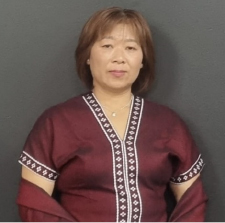Bridging Cultures Through Language | Amie Se’s Role as a Chin Haka Interpreter
Amie, originally from Myanmar, a country home to around 50 languages and countless dialects and sub-dialects, is a professional Burmese and Chin Haka interpreter. Based in Auckland, she has been practicing for over 10 years and is currently the only Chin Haka interpreter in the region.
Amie Se primarily interprets in physical and mental health settings, mostly within the Waitematā and Auckland localities. She is also frequently contracted by the Ministry of Business, Innovation and Employment (MBIE) to interpret at the Te Āhuru Mōwai o Aotearoa (Māngere Refugee Resettlement Centre).
Due to the small size of the Myanmar community in Auckland, Amie is well known in her field. She acknowledges that this can make avoiding conflicts of interest challenging at times. However, she emphasizes the importance of adhering to the Interpreter’s Code of Ethics, which requires confidentiality, maintaining professional boundaries, and interpreting accurately without altering the meaning of what is being said.
Amie notes that interpreting word-for-word is not always possible, especially when dealing with complex or abstract concepts. She highlights the importance of practitioners avoiding jargon, idioms, and metaphors, and checking with interpreters whether direct translations exist for specific terms. Clear and culturally sensitive communication is essential—particularly when discussing topics that may carry stigma in the community, such as mental health, family harm, or reproductive health.
While interpreters are not permitted to alter or add to what is being said, they can act as cultural mediators when appropriate, helping practitioners understand cultural nuances. Best practice guidelines recommend conducting a pre-brief with interpreters to identify potential challenges, clarify cultural considerations, and outline the interpreting process. Amie says that although pre-briefs are essential, they are rarely conducted, leaving interpreters unprepared for what may unfold during sessions.
De-briefing with interpreters is also recommended, offering a chance to reflect, learn, and strengthen the practitioner–interpreter relationship. This relationship is vital for building trust with patients and ensuring effective communication.
Amie stresses the importance of practitioners speaking clearly and naturally, using short sentences (two to three at a time), and avoiding slang or idioms. It is also the practitioner’s responsibility to explain the interpreter’s role and ensure patients understand the interpreting process. Sessions involving interpreters typically require double the time, yet Amie notes that many GP practices still book only 15-minute appointments.
She also observes a growing trend toward phone interpreting. While suitable for some appointments, onsite interpreting remains crucial for others. Unfortunately, untrained individuals—such as relatives, friends, community members, or bilingual staff—are often used as interpreters. Evidence shows this practice can reduce the quality of care and lead to repeated visits due to miscommunication. Issues such as gatekeeping, personal agendas, and lack of language proficiency contribute to these risks.
When booking interpreters, it’s important to consider gender and dialect preferences. Amie recommends checking interpreter availability before scheduling appointments. She also cautions against relying solely on text messages for appointment details, as this can cause confusion. Booking coordinators and practitioners should confirm that patients understand the service, reason, location, date, and time of their appointments.
Despite the challenges, Amie finds deep fulfillment in her work. She describes herself as a “bridge between languages,” helping people communicate and contributing to better outcomes for all.
